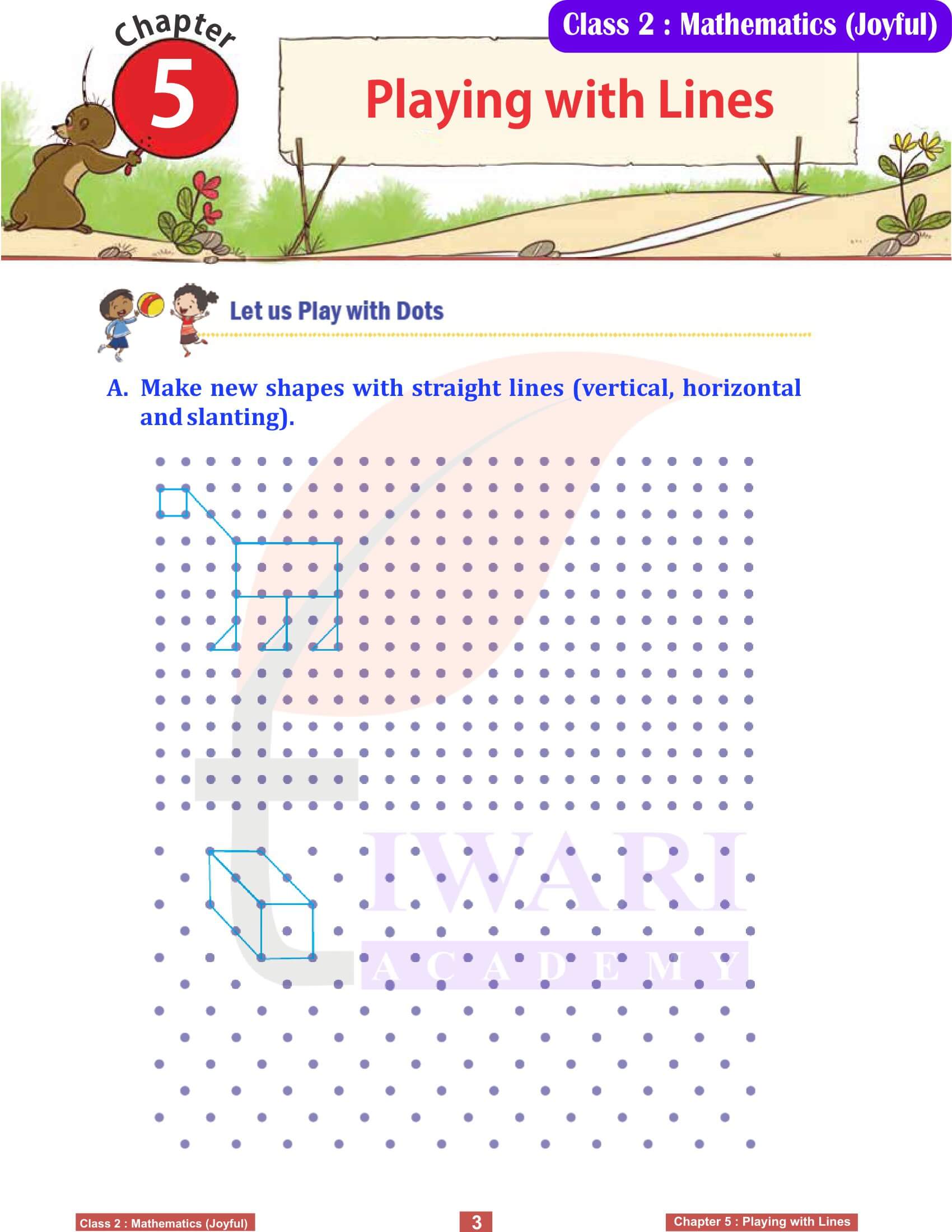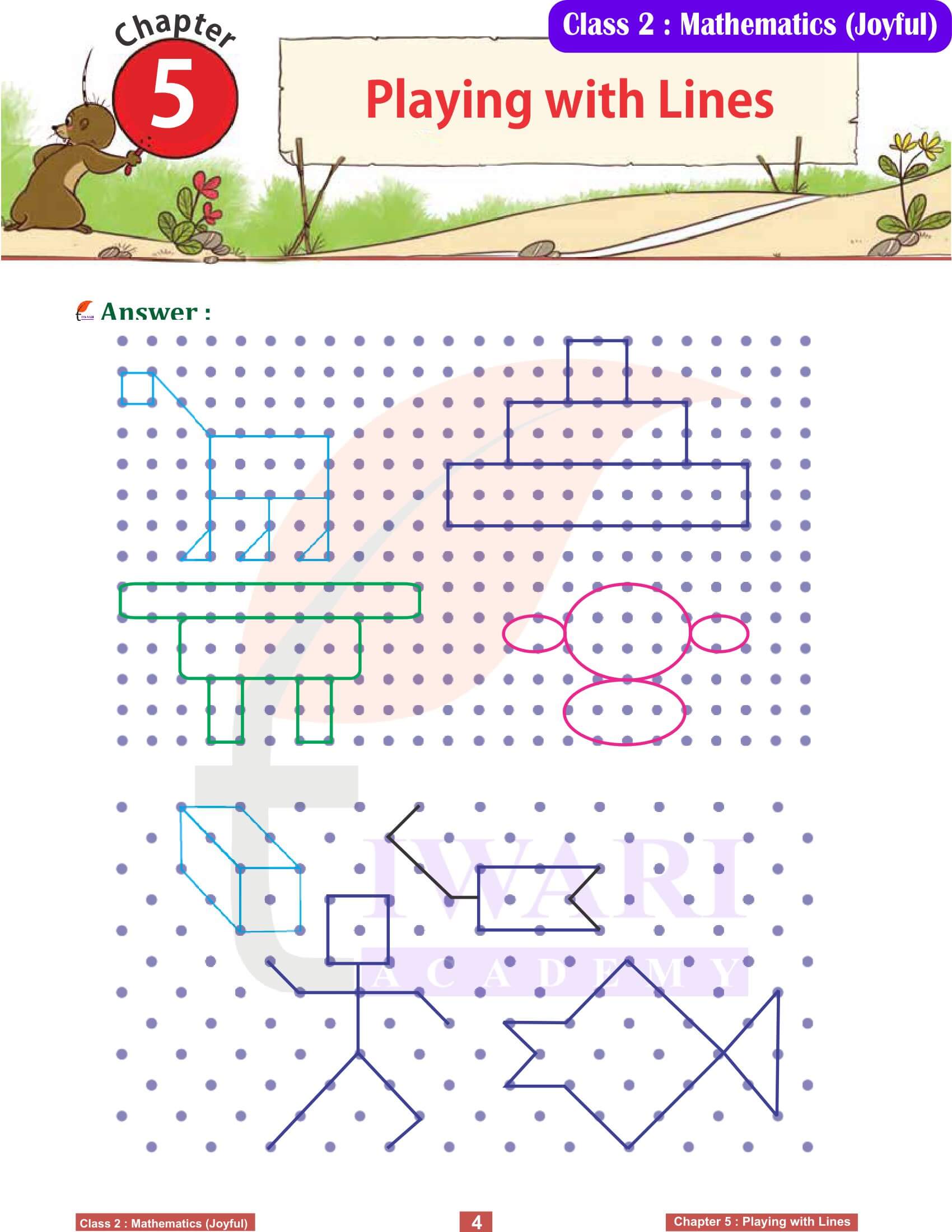NCERT Solutions for Class 2 Joyful Maths Chapter 5 Playing with Lines (Orientations of a line) in Hindi and English Medium revised and updated for session 2025-26. Class 2 Maths Chapter 5 teaches us about the use of number line. NCERT Class 2 Maths Textbook Chapter 5 Playing with Lines, introduces young learners to the fascinating world of line orientations. This chapter focuses on types of lines, such as horizontal, vertical, slanting and curved lines, helping students understand their properties and applications. Through engaging activities and worksheets, students learn to identify and differentiate between these lines in their surroundings.
Class 2 Joyful Maths Chapter 5 Playing with Lines Solutions
For instance, drawing exercises and playful activities are used to teach curved lines and slanting lines. Teachers and parents can utilize the NCERT Class 2 Maths Chapter 5 PDF for structured lessons, while interactive videos offer additional support to clarify the concepts. These resources make understanding lines enjoyable and effective for students.
Study Plan for Class 2 Math
Study Plan for Class 2 Final Exam
To further enhance learning, Class 2 Maths Chapter 5 solutions and practice exercises encourage students to apply their knowledge in real-life scenarios. Identifying horizontal and vertical lines in everyday objects, such as windows and doors, builds observational skills. Joyful Math NCERT Textbook Class 2 Chapter 5 questions, answers and lesson plans are essential tools for teachers to simplify complex concepts. Worksheets focused on line drawing activities ensure students grasp the orientations of a line. Whether it’s through teaching lines to Class 2 students or creating lesson plans, the chapter emphasizes hands-on learning. These methods make Chapter 5 a crucial part of the Class 2 Maths curriculum, fostering creativity and curiosity in young minds.
Class 2 Maths Chapter 5 Playing with Lines (Orientations of a line)
In the realm of Class 2 Mathematics, Chapter 5 Playing with Lines introduces young learners to the basic concept of lines, an essential element in geometry. Lines are everywhere, forming the edges of objects, shaping letters and numbers, and creating patterns and designs. This chapter aims to familiarize students with the concept of lines through playful and engaging activities. By observing their surroundings, children start to recognize lines in different objects, understanding their omnipresence in both natural and man-made structures. This foundational knowledge sets the stage for more complex geometrical concepts, emphasizing the role of lines in forming shapes and defining spaces.
Understanding Different Types of Lines
Class 2 Maths NCERT Chapter 5 delves into the classification of lines based on their orientations, which is crucial for young learners to grasp the diverse nature of lines they encounter. The chapter categorizes lines into horizontal, vertical, and slanted orientations, making it easier for students to identify and differentiate them in various contexts. Horizontal lines run from left to right, vertical lines move up and down, while slanted lines lean at an angle. Through illustrations and hands-on activities, children learn to observe these lines in their environment, enhancing their visual and spatial awareness while associating each type with its corresponding orientation.
Horizontal Lines: Exploring Stability and Rest
Horizontal lines suggest stability and rest, reminiscent of the horizon where the sky meets the earth. Here, students explore horizontal lines through engaging activities, such as identifying these lines in classroom objects, books, and even in art. The NCERT Math exercises aim to reinforce the concept of horizontal orientation, illustrating how these lines are parallel to the ground. By drawing, tracing and spotting horizontal lines, children not only enhance their motor skills but also develop an intuitive understanding of this orientation, recognizing its calm and steady nature.
Vertical Lines: Signifying Strength and Growth
Vertical lines are introduced as symbols of strength and growth, pointing upwards towards the sky. This section encourages children to observe and interact with vertical lines, identifying them in trees, buildings, and their own standing posture. Activities may include drawing vertical lines, comparing their lengths and using them to create simple figures or patterns. This hands-on approach helps students associate vertical lines with upward movement and growth, fostering a sense of dynamism and elevation in their perception.
Slanted Lines: Understanding Dynamism and Movement
Slanted lines, with their dynamic and active nature, add a sense of motion and excitement to the mix. This section focuses on helping students recognize and categorize slanted lines, which are neither horizontal nor vertical but at an angle. Through playful activities like drawing slanted lines to connect dots or tracing them in artwork, children learn to appreciate the energy and movement these lines convey. The emphasis is on observing how slanted lines can depict action and inclination, enriching students’ understanding of line orientations and their expressive potential.
Integrating Knowledge of Line Orientations
The concluding section of NCERT Chapter 5 in Class 2 Maths encapsulates the importance of understanding line orientations and their applications. It reinforces how the ability to distinguish between horizontal, vertical, and slanted lines enhances students’ visual literacy, crucial for their subsequent learning in geometry and beyond. By integrating this knowledge into daily observations and activities, children develop a foundational geometric skill set that supports their academic growth.
The chapter 5 of class 2 mathematics emphasizes the joy of discovery and understanding, encouraging students to continue exploring lines and their orientations in the world around them.
What are the key types of lines taught in Class 2 Maths Chapter 5?
In Class 2 Maths Chapter 5, students learn about horizontal, vertical, slanting, and curved lines. These line orientations are introduced through engaging activities, examples from daily life, and drawing exercises. For instance, horizontal lines are like the horizon, vertical lines resemble tall trees, and slanting lines are seen in slides. Curved lines, on the other hand, can be found in items like a bowl’s edge. These concepts help young learners develop spatial awareness and observation skills, making their understanding of line orientations more practical and enjoyable.
Is the preparation of Class 2 Maths Chapter 5 easy?
Yes, the preparation of Class 2 Maths Chapter 5, Playing with Lines, is relatively easy and enjoyable. The chapter introduces basic concepts of horizontal, vertical, slanting and curved lines in a fun and interactive manner. With the help of engaging activities, worksheets, and examples from daily life, children can easily grasp these concepts. Resources like the NCERT Class 2 Maths Chapter 5 PDF, videos and solutions make learning more structured and accessible. Additionally, teachers and parents can guide students using playful exercises and practice questions, ensuring that the learning experience is both simple and effective for young learners.
How can parents and teachers help students understand line orientations better?
Parents and teachers can enhance learning by using resources like NCERT Class 2 Maths Chapter 5 PDFs, solutions and interactive videos. Activities such as identifying horizontal, vertical, and slanting lines in everyday objects or drawing curved lines with crayons make learning engaging. Worksheets and practice questions also provide additional support. Joyful Maths Chapter 5 solutions simplify concepts, while lesson plans offer a structured approach. Encouraging students to observe and relate lines to real-world objects fosters curiosity and creativity, making the learning process both fun and effective.
What is the main goal about Class 2 Maths Chapter 5?
The main goal of Class 2 Maths Chapter 5, Playing with Lines, is to help students understand the different types of lines—horizontal, vertical, slanting and curved—and their orientations. This chapter aims to build spatial awareness by encouraging children to observe and identify these lines in everyday objects, such as doors, windows, and slides. Through engaging activities, drawing exercises and real-world examples, students develop foundational skills in recognizing and differentiating between these lines. The chapter fosters creativity, enhances observation skills, and lays the groundwork for understanding geometry in higher classes.





